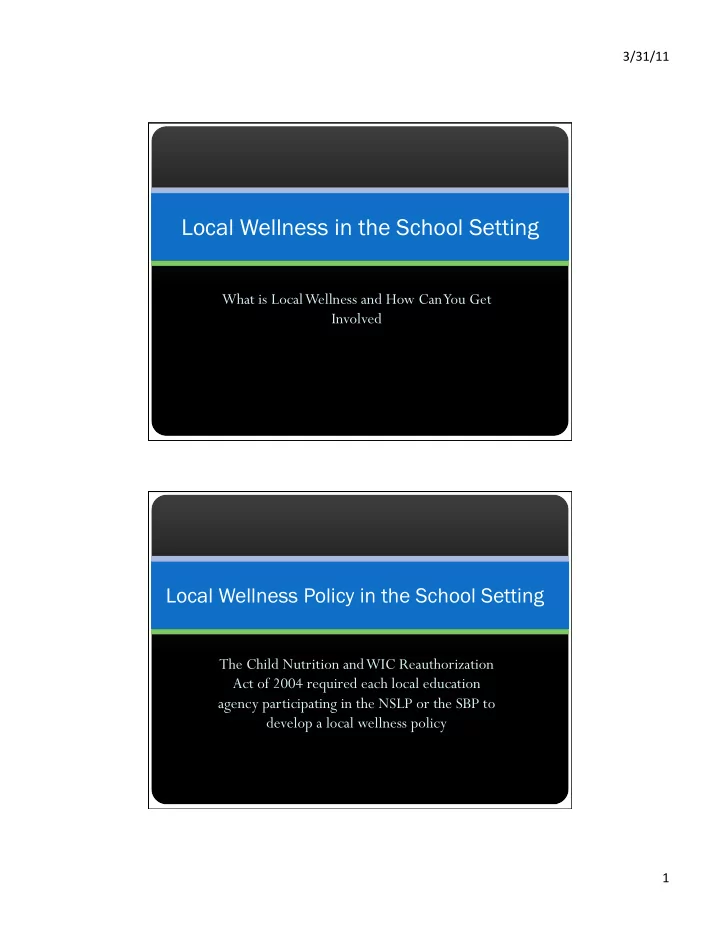

3/31/11 ¡ Local Wellness in the School Setting What is Local Wellness and How Can You Get Involved Local Wellness Policy in the School Setting The Child Nutrition and WIC Reauthorization Act of 2004 required each local education agency participating in the NSLP or the SBP to develop a local wellness policy 1 ¡
3/31/11 ¡ Local Wellness Policy in the School Setting This policy places the responsibility of developing a wellness policy at the county level, so the individual needs of each school can be addressed Count nty L y Local W l Wellne llness P Poli licy y Requires Goals for: ü Nutrition education ü Physical activity ü Other school based activities ü Nutrition Guidelines for all Foods and Beverages on School Campus • Designed to promote student wellness 2 ¡
3/31/11 ¡ Local Wellness Policy The federal mandate is intended to encourage sites to serve more healthy food to children, provide more opportunities for physical activity and confront the costly public health threat of obesity Policy Requirements Develop a plan to measure the implementation of policies Designate one or more persons charged with operational responsibility for ensuring that the goals of the local wellness policy are fulfilled Involve a broad group of members (school and community) 3 ¡
3/31/11 ¡ Local Wellness Councils At County Level At School Level Count nty L LWC R Respons nsibili lities Review schools strengths and weaknesses and revise county policy to meet the health and wellness needs of all students Design and/or support programs to improve student health and proper development of children Identify strategies & opportunities for schools, families and communities to come together to develop this vision Advise school leaders on assessing and implementing the overall goals 4 ¡
3/31/11 ¡ Scho hool LWC Responsibilities Conduct the School Health Index at each school (School Health Index http://apps.nccd.cdc.gov) LWC will determine who on the Council will conduct the index Summarize the strengths and weaknesses Implement activities Record activities Summarize activities Report to County LWC Local W l Wellne llness C Counc ncil M l Memb mbers Superintendent Board Member Principals Teachers Food Service Staff School Nurses Parents Students Community Leaders – County Commission, Mayor, Youth Organizations Booster Organizations Health Care Providers ( physicians, dietitians, exercise physiologists, dentists, nurses, physician assistants, etc) 5 ¡
3/31/11 ¡ Poli licy De y Develo lopme ment nt Review and compile the completed baseline assessments 1. for each school Determine areas in need of improvement 2. Develop work plans and activities to address each area 3. Implement work plans 4. Monitor and review progress 5. Evaluate the progress 6. Review, revise and update 7. Im Imple leme ment nt. . Evalu luate. . Im Improve. . Keep the cycle going… 6 ¡
3/31/11 ¡ Social ecological model Individual Relationship Institutional Community Societal Poli licy a y and nd E Environme nment ntal C l Cha hang nge Example le o of E Event nts Example les Celebrating F/V More Matters Week Adding a salad bar Making the school athletic facilities available Hosting a Family Fitness Night to community members Establishing a policy that allows teachers to Providing health screenings for school staff walk on their planning period or to take students to gym/track to walk and learn Establishing a Safe Routes to School Participate in Walk to School Day Program Providing healthy snacks or breakfast during Adopting Healthy Food & Beverage testing Concession Policy Health and education go hand in hand: one cannot exist without the other. To believe any differently is to hamper progress. Just as our children have a right to receive the best education available, they have a right to be healthy. As parents, legislators, and educators, it is up to us to see that this becomes a reality. Dr. Antonia Novello, Former US Surgeon General, 1992 7 ¡
3/31/11 ¡ Policy and Environmental Changes to Advocate for During Local Wellness Meetings Breakfast after first or breakfast in the classroom Fruits and vegetables during school parties and functions Recess before lunch Healthy affordable options at concession stands Walk and talk periods before homeroom Pleasant cafeteria environments including time requirements “Jam a Minute” throughout the school day Staff as role models Conne nnecting ng N Nutrition C n Conc ncepts a across t the he C Curriculu lum m Language Arts — Read books with fruit and vegetable themes. Describe and discuss the colors, shapes, textures and tastes of the different types of fruits and vegetables featured in these books. Social Studies and Geography — Learn about states and countries where certain fruits and vegetables are grown. Map countries that are major producers of specific fruits and vegetables. Mathematics — Have students track the number of servings of fruits and vegetables they eat for two days by placing stickers on a classroom chart. Count the number of fruits and vegetables and have students determine the following: What fruit is eaten most often? What vegetable is eaten most often? Science — Conduct a Bean Olympics. Plant bean seeds in a shallow pan. Tape a number to a penny and place over each seed. The first bean to sprout and turn over its penny wins. 8 ¡
3/31/11 ¡ How Do Do Y You B Become me a an A n Advocate f for Student nt H Healt lth? h? Obtain a copy of the wellness policy and review 1. Join your county’s or school’s wellness 2. committee Seek out allies 3. Work on easy but lasting successes that match 4. with the policy Promote successes 5. Contact info: Celeste Peggs, MS, RD, LD Kristy Blower, MA Coordinator, WVDE Coordinator, WVDE Office of Child Nutrition Office of Child Nutrition crpeggs@access.k12.wv.us kblower@access.k12.wv.us 304-558-3396 304-558-3396 9 ¡
Recommend
More recommend